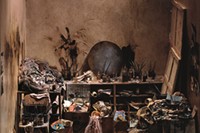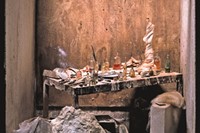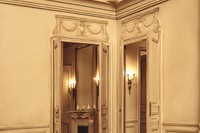Set in a specially constructed labyrinth in Kings Cross, the forthcoming Charles Matton: Enclosures exhibition will display 38 of the late artist’s undiscovered boxes. These works are some of the most endearing pieces from his oeuvre and are best
Set in a specially constructed labyrinth in Kings Cross, the forthcoming Charles Matton: Enclosures exhibition will display 38 of the late artist’s undiscovered boxes. These works are some of the most endearing pieces from his oeuvre and are best described as artistic microcosms, representing interiors at one-seventh of their actual scale. Matton regarded them as “magic boxes and metaphysical boxes”, and they represented bedrooms, hotels, libraries, lofts and studios. Giving an insight in both his imagination and the private lives of artists and literary figures such as Alberto Giacometti, Edward Hopper and Sigmund Freud.
One of the most dominant works in the series is Francis Bacon’s Studio (1987), which saw Matton approach the private life of the British painter with haunting realism and brutality. A few years later Matton explained why he produced the work, “a photograph of (Francis Bacon) had haunted me for a long time; a fuzzy, ghostly outline, anchored in the middle of his studio, an indescribable heap of pots, brushes, rags, magazines and unidentifiable treasures. I paid homage to him even though I had to break into his place uninvited…we were never to meet, but that blurred silhouette and those paintings will always haunt me” (1992). Other notable works include the 1999 series William Burroughs’s bedroom in Tangiers and The bedroom of the disorderly woman (1991). To accompany the exhibition, French publishers Flammarion have released a book containing 500 images that source through Matton’s varied career and a preface by French cultural theorist Paul Virilo which explores the artists’ relationship with realism – describing the enclosures as “a reality subjected to disproportion”.
Matton originally began his career as a painter, but worked later as a draftsman, sculptor, photographer, filmmaker and writer – often merging these creative processes together in his later work. The boxes themselves are intricately constructed and saw Matton design, draw, build, sculpt and paint them. His wife Sylvie Matton observed his entire work process and told AnOther, “At first he didn’t make them to show them, but to use as a tool to produce photographs. His first exhibition contained the paintings, photographs of the interiors and finally the boxes. It was to make the public believe that the photograph was an honest representation of the space. It was to create this illusion”.
Charles Matton: Enclosures will run from September 8 – October 7 2011 at All Visual Arts, 2 Omega Place, London N1 9DR. The book Charles Matton, published by Flammarion is on sale now.
Text by Isabella Burley






